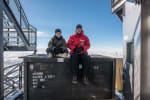There’s always something going on at the Pole, and last week was no different. On the fun side, the winterovers got in some outdoor photography—well, technically indoors for this shot of the icy stairwell down in the fuel arches […]
News
Week 48 at the Pole
The many flight delays this season affected the arrival of not only personnel but cargo, too. It eventually showed up though, and last week IceCube’s winterovers were busy managing it all at the IceCube Lab. It was a lot of carrying and exhausting, but they were still smiling after it was all said and done […]
Week 47 at the Pole
It was a busy week for IceCube’s newest winterovers. A plane arrived after a long hiatus, bringing some new folks to the station and taking away last year’s winterovers, finally. But much of the excitement came from alarms going off—the ones for fire were false alarms thankfully. But it gave the new winterovers a chance to apply their training to emergency response operations. […]
Week 46 at the Pole
Last week kept IceCube’s newest winterovers busy, but not too busy, with a number of activities. Johannes was on call, and got his first page to deal with a detector issue, but not too big of a problem. Both winterovers were trained on the PistenBully, or snowcat, and then drove around to the IceTop stations to take snow height measurements. […]
A first look at how the Earth stops high-energy neutrinos in their tracks
Neutrinos are abundant subatomic particles that are famous for passing through anything and everything, only very rarely interacting with matter. Now, scientists have demonstrated that the Earth stops very energetic neutrinos—they do not go through everything. The study is published online today by the journal Nature. […]
Week 45 at the Pole
Flight canceled? Well, that happens. But, canceled … again? Welcome to plane travel at the Pole. The changeable weather patterns in the harsh climate of Antarctica make flights in and out susceptible to delays. It’s part and parcel of the whole experience. […]
Week 44 at the Pole
Lots of firsts as a new summer season begins at the South Pole. Last week saw the first LC-30 to arrive, seen here as it’s being marshaled in and later after landing and releasing a group of red parkas onto the ice, the first group of many to come. The changing-of-the-guard period at the Pole has begun. […]
Week 43 at the Pole
Shoveling snow might not be that much fun, but at least at the South Pole, afterward you can walk away with a pretty “epic” beard, as the winterovers recently put it. Well, if you have a beard to begin with, that is. […]
Week 42 at the Pole
After a long, cold winter at the South Pole, it might be hard to decide which is more exciting: the first plane of the season or its contents. Apparently, people get pretty excited at the sight of a bowl of tangerines after going without any fresh fruit for eight or nine months. […]
PolarTREC teacher joins neutrino hunters at the South Pole
PolarTREC research experiences connect teachers and scientists in a life-changing experience
that nurtures transformative science learning in the classroom. […]









